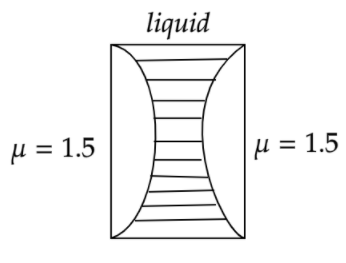
The effective focal length of the lens combination shown in the figure is

A)
B)
C)
D)

Answer
486k+ views
Hint: In case of using a single lens, there is only one optical element. In contrast to this, a compound lens is an array or combination of simple lenses having a common axis. Usually, the lenses are placed in contact with each other but sometimes we put a material between the lenses such as done in this question. In the case of lens combination, the powers of the lenses are added.
Formula Used:
Complete step by step solution:
We know that power of a lens is the reciprocal of its focal length and the powers in a lens combination are added. Hence we can say that the effective power of the combination will be equal to the sum of the powers of the two Plano-convex lenses and the power of the concave lens which the liquid is forming. Mathematically,
Substituting power by the reciprocal of focal lengths, we get
It is to be noted that for the plane surface of the Plano-convex lenses, the radius of curvature of the surface will be infinite, that is
Hence, the reciprocal of the radius of the plane surface will be zero, since
The expression for the focal lengths of the lenses can be written as,
The effective focal length of the combination is given to be
The radius of curvature of the curved surfaces
The values of the focal lengths will be as given below
Similarly, for the lens formed by the liquid, we have
Substituting these values in
Hence (D) is the correct option.
Note: The most common error which students make in such problems is in the substitution of the values of focal length and the radius of curvature. The sign convention is extremely important in numerical optics since one misplaced minus sign can waste the entire effort put into the question. The distance measured along the direction of motion of light ray is taken to be positive and those opposite are taken negatively.
Formula Used:
Complete step by step solution:
We know that power of a lens is the reciprocal of its focal length and the powers in a lens combination are added. Hence we can say that the effective power of the combination will be equal to the sum of the powers of the two Plano-convex lenses and the power of the concave lens which the liquid is forming. Mathematically,
Substituting power by the reciprocal of focal lengths, we get
It is to be noted that for the plane surface of the Plano-convex lenses, the radius of curvature of the surface will be infinite, that is
Hence, the reciprocal of the radius of the plane surface will be zero, since
The expression for the focal lengths of the lenses can be written as,
The effective focal length of the combination is given to be
The radius of curvature of the curved surfaces
The values of the focal lengths will be as given below
Similarly, for the lens formed by the liquid, we have
Substituting these values in
Hence (D) is the correct option.
Note: The most common error which students make in such problems is in the substitution of the values of focal length and the radius of curvature. The sign convention is extremely important in numerical optics since one misplaced minus sign can waste the entire effort put into the question. The distance measured along the direction of motion of light ray is taken to be positive and those opposite are taken negatively.
Latest Vedantu courses for you
Grade 9 | CBSE | SCHOOL | English
Vedantu 9 CBSE Pro Course - (2025-26)
School Full course for CBSE students
₹37,300 per year
Recently Updated Pages
Master Class 12 Business Studies: Engaging Questions & Answers for Success

Master Class 12 English: Engaging Questions & Answers for Success

Master Class 12 Social Science: Engaging Questions & Answers for Success

Master Class 12 Chemistry: Engaging Questions & Answers for Success

Class 12 Question and Answer - Your Ultimate Solutions Guide

Master Class 11 Economics: Engaging Questions & Answers for Success

Trending doubts
Draw a labelled sketch of the human eye class 12 physics CBSE

a Tabulate the differences in the characteristics of class 12 chemistry CBSE

Which one of the following is a true fish A Jellyfish class 12 biology CBSE

Why is the cell called the structural and functional class 12 biology CBSE

Differentiate between homogeneous and heterogeneous class 12 chemistry CBSE

Write the difference between solid liquid and gas class 12 chemistry CBSE




